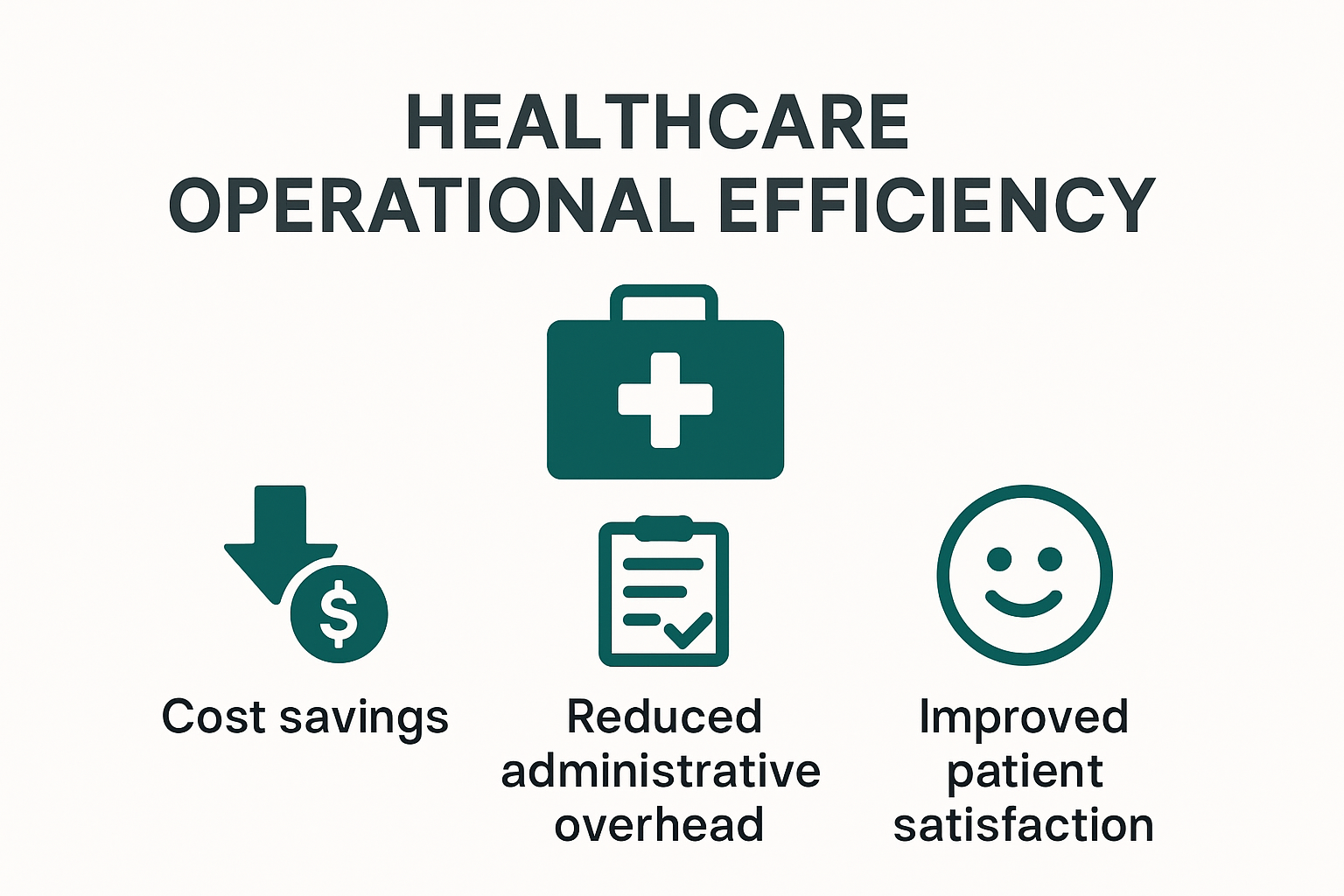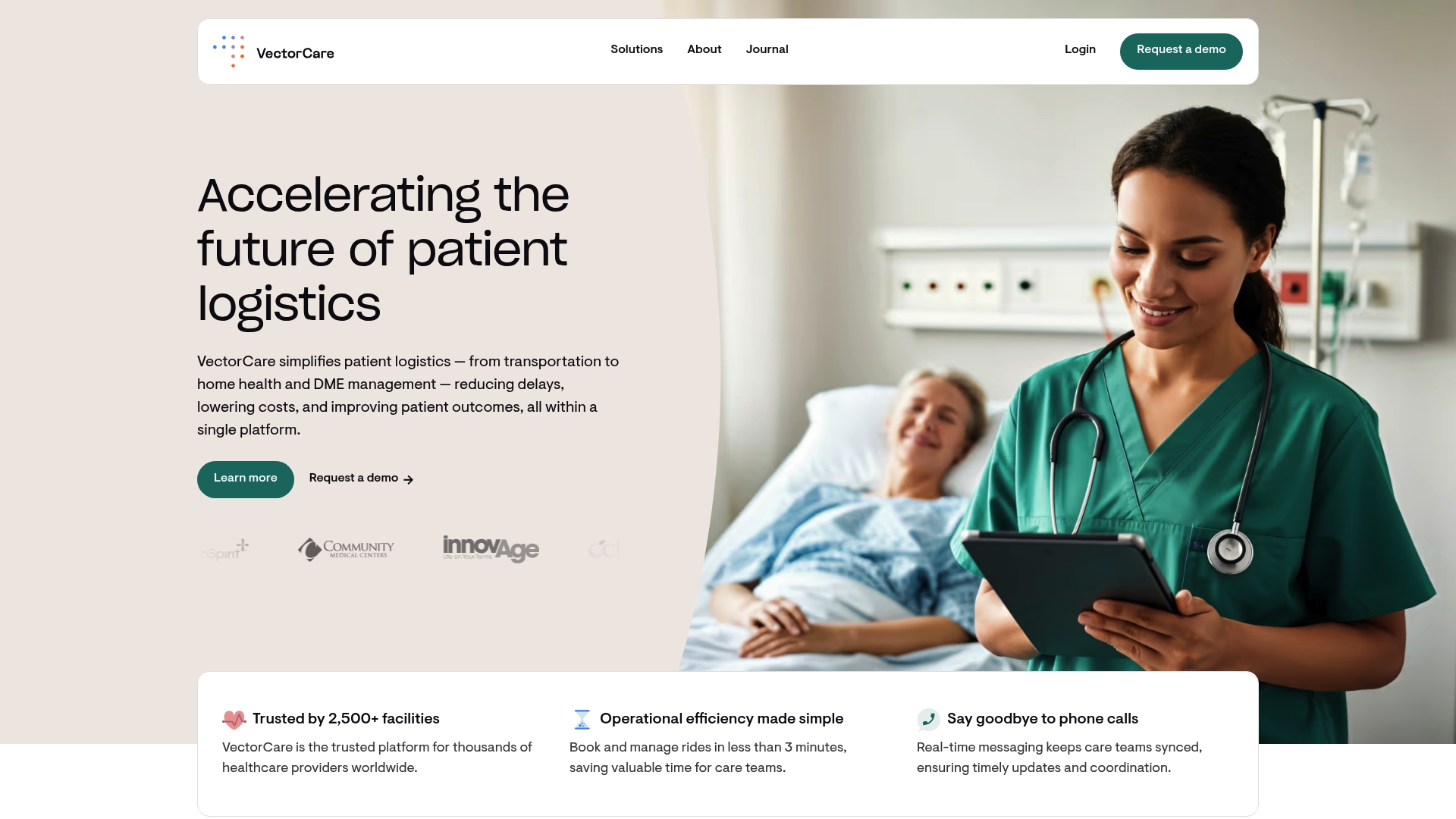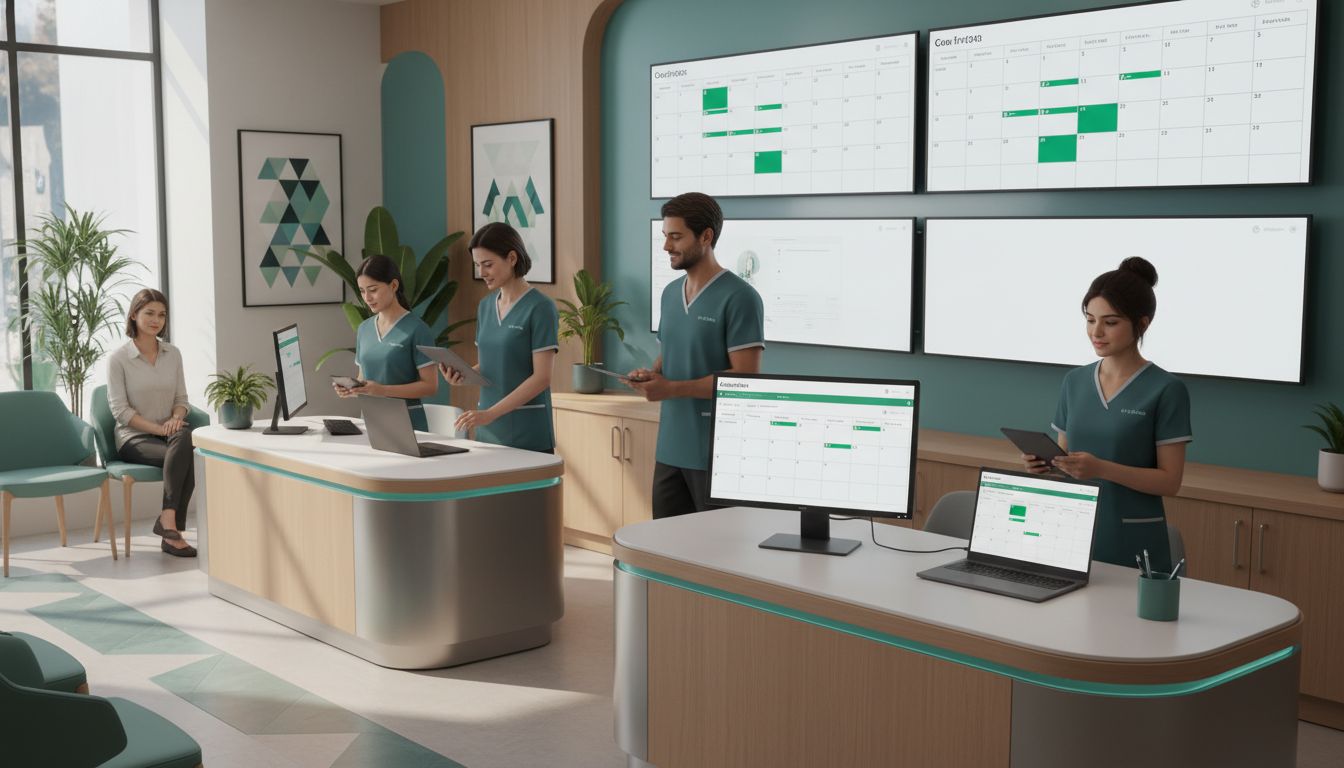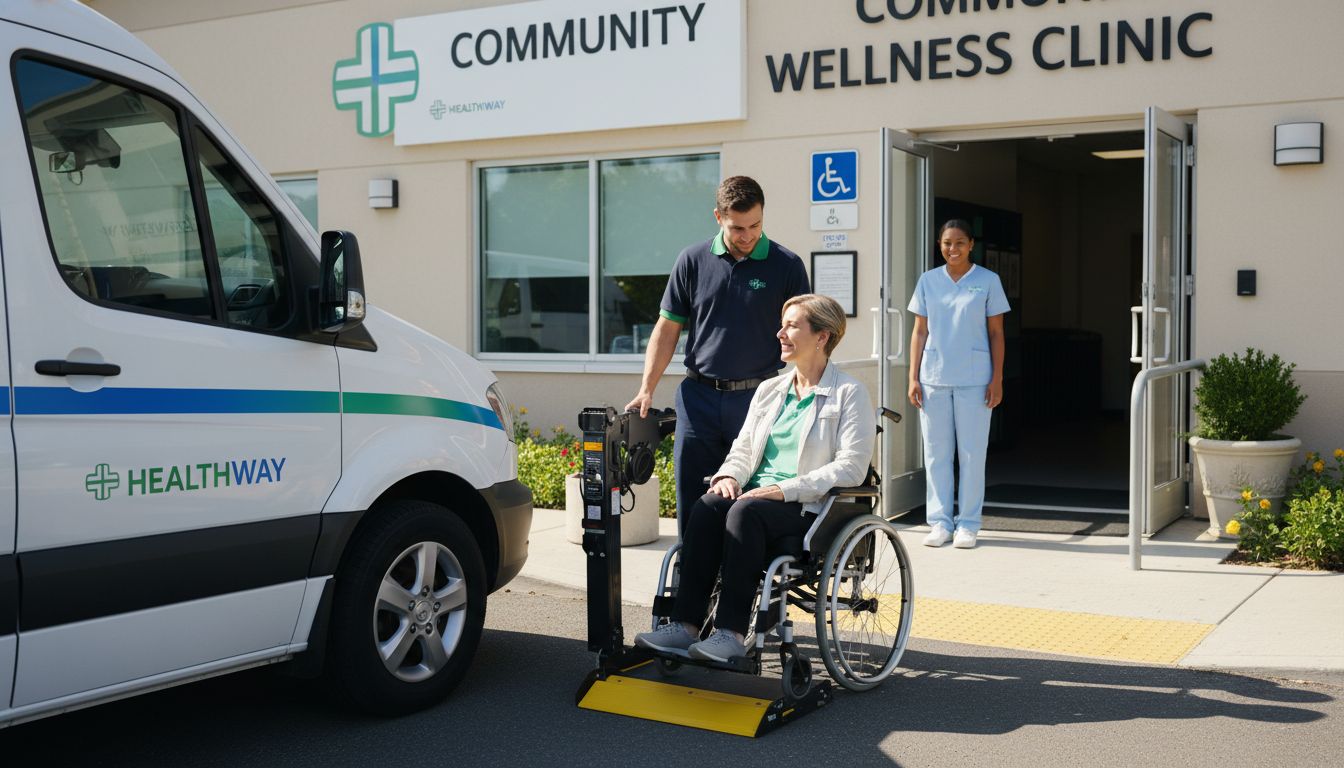Healthcare Operational Efficiency Strategies for 2025 Success

Hospitals and clinics across the country are striving to do more with less as patient expectations and operational costs reach new highs. Yet, even with tight budgets, healthcare organizations that prioritize operational efficiency can slash administrative overhead by up to 25 percent while actually boosting patient satisfaction. The real surprise here is that cutting costs does not require sacrificing care quality at all—in fact, the smartest strategies make everything run smoother for both staff and patients.
Table of Contents
- Understanding Healthcare Operational Efficiency
- Key Strategies To Streamline Operations
- Technology Solutions Impacting Efficiency
- Best Practices For Diverse Healthcare Settings
Quick Summary
| Takeaway | Explanation |
|---|---|
| Focus on Operational Efficiency | Healthcare organizations should prioritize maximizing performance, minimizing waste, and reducing costs through streamlined processes and technology integration. |
| Implement Predictive Workforce Management | Utilizing predictive scheduling tools can effectively align staff availability with patient demand, decreasing overtime costs and improving staff satisfaction. |
| Adopt Technology Solutions | Integration of advanced technologies like EHRs and AI analytics is essential for reducing administrative burdens, improving patient care, and enhancing operational efficiency. |
| Standardize Processes | Standardizing clinical and administrative processes can lead to significant operational improvements, including increased surgical volume and reduced waste. |
| Lean Management Approach | Embracing lean management principles helps healthcare organizations identify inefficiencies and foster a culture of continuous improvement, leading to more responsive operations. |
Understanding Healthcare Operational Efficiency
Healthcare operational efficiency represents a critical strategic approach for modern medical organizations to optimize resource utilization, improve patient outcomes, and reduce unnecessary administrative complexities. At its core, operational efficiency in healthcare focuses on maximizing organizational performance while minimizing waste, reducing costs, and enhancing overall service delivery.

The Foundational Elements of Healthcare Efficiency
Operational efficiency in healthcare is not simply about cutting costs but creating a holistic system that streamlines processes, leverages technology, and prioritizes patient care. Research from the American Hospital Association indicates that healthcare organizations that successfully implement operational efficiency strategies can reduce administrative overhead by up to 25% while simultaneously improving patient satisfaction and care quality.
Key components of healthcare operational efficiency include workflow optimization, technology integration, and data-driven decision making. By implementing lean management techniques, healthcare providers can systematically identify and eliminate unnecessary steps in patient care processes. According to a study published by the National Center for Biotechnology Information, organizations that adopt comprehensive efficiency strategies can reduce operational costs by 15-20% without compromising patient care quality.
Here is a summary table highlighting the foundational elements and their impacts, as discussed in this section:
| Foundational Element | Description | Reported Impact |
|---|---|---|
| Workflow Optimization | Removing unnecessary steps in care processes | Reduces costs by 15-20% |
| Technology Integration | Leveraging EHRs, automation, and analytics | Cuts admin overhead by up to 25% |
| Data-Driven Decision Making | Using KPIs and analytics for organizational effectiveness | Sustains continuous improvement |
| Lean Management Techniques | Eliminating waste and fostering ongoing improvement | Improves patient satisfaction |
| Process Standardization | Implementing protocols for consistency | Enhances service quality |
Technology and Process Transformation
Advanced technologies play a pivotal role in transforming healthcare operational efficiency. Electronic Health Records (EHRs) and automated patient management systems create centralized, accessible platforms that dramatically reduce administrative tasks and minimize potential errors. Research from the Healthcare Information and Management Systems Society demonstrates that integrated technological solutions can help healthcare providers reduce documentation time by 30-40%, allowing medical professionals to focus more on direct patient care.
Staff scheduling optimization represents another critical area of operational efficiency. By utilizing sophisticated software with real-time data analytics, healthcare facilities can create dynamic scheduling models that align staff availability precisely with patient needs. This approach ensures appropriate staffing levels, reduces resource waste, and improves overall organizational responsiveness.
Data-Driven Performance Metrics
Measuring and tracking operational efficiency requires robust performance metrics and continuous improvement strategies. Key performance indicators (KPIs) such as patient wait times, resource utilization rates, staff productivity, and cost per patient encounter provide valuable insights into organizational effectiveness. Healthcare leaders who implement comprehensive monitoring systems can make informed decisions that drive continuous improvement and strategic growth.
Successful healthcare operational efficiency is not a one-time initiative but an ongoing commitment to innovation, technological integration, and process refinement. By embracing a holistic approach that combines advanced technologies, strategic process design, and data-driven insights, healthcare organizations can create more responsive, cost-effective, and patient-centered service models.
Key Strategies to Streamline Operations
Healthcare organizations seeking to enhance operational efficiency must adopt comprehensive strategies that address complex systemic challenges while maintaining high-quality patient care. These strategies require a multifaceted approach integrating technological innovation, process optimization, and strategic resource management.
Predictive Workforce Management
Workforce optimization represents a critical component of healthcare operational efficiency. Research from Surgical Directions reveals that implementing predictive scheduling tools can reduce overtime expenditures by 15-20% while simultaneously improving staff satisfaction. Advanced scheduling technologies enable healthcare administrators to align staffing resources precisely with anticipated patient demand, creating more dynamic and responsive organizational structures.
Predictive workforce management goes beyond simple scheduling. By integrating real-time data analytics, healthcare organizations can develop sophisticated staffing models that account for patient volume fluctuations, staff skill sets, and potential resource constraints. These intelligent systems help minimize understaffing risks while preventing unnecessary labor expenditures.
Process Standardization and Workflow Optimization
Standardizing clinical and administrative processes is fundamental to achieving operational efficiency. According to industry research, healthcare organizations that implement structured workflow protocols can increase surgical case volume by 10-15% annually. Standardization efforts should focus on critical areas such as preoperative readiness, surgical start times, sterile processing, and room turnover procedures.
Workflow optimization involves systematically mapping existing processes, identifying bottlenecks, and redesigning systems to eliminate unnecessary steps. This approach requires collaboration between clinical staff, administrators, and technology experts to create streamlined, patient-centered workflows that reduce administrative burden and enhance overall operational performance.
Advanced Technology Integration
Technology plays a transformative role in healthcare operational efficiency. Surgical Directions research indicates that AI-driven analytics and automation in operating room management can generate 12-18% efficiency improvements by reducing case delays and enhancing scheduling accuracy.
Successful technology integration requires more than implementing new software systems. Healthcare organizations must develop comprehensive digital transformation strategies that include staff training, change management, and continuous performance monitoring. This holistic approach ensures that technological investments translate into tangible operational improvements.
Critical technological interventions include advanced Electronic Health Record (EHR) systems, real-time communication platforms, predictive analytics tools, and automated scheduling software. These technologies enable healthcare providers to make data-driven decisions, reduce administrative overhead, and create more responsive patient care environments.
Streamlining healthcare operations is an ongoing process that demands continuous adaptation, strategic investment, and a commitment to innovation. By embracing comprehensive strategies that integrate workforce optimization, process standardization, and advanced technologies, healthcare organizations can build more efficient, resilient, and patient-focused operational models.

Technology Solutions Impacting Efficiency
Technology has emerged as a transformative force in healthcare operational efficiency, providing innovative solutions that dramatically reshape how medical organizations manage resources, deliver patient care, and optimize administrative processes. As healthcare systems become increasingly complex, technological interventions offer strategic pathways to enhance performance and reduce operational friction.
Digital Transformation and Strategic Technology Adoption
According to a 2025 Deloitte survey, over 70% of health system executives prioritize enhancing operational efficiency through digital technologies. This strategic shift reflects a growing recognition that technological solutions are no longer optional but essential for maintaining competitive advantage and delivering high-quality patient care.
The landscape of healthcare technology solutions encompasses a wide range of sophisticated tools designed to address specific operational challenges. These include artificial intelligence (AI) powered analytics platforms, machine learning algorithms for predictive diagnostics, automated scheduling systems, and integrated communication networks that enable real-time information exchange across different healthcare departments.
Electronic Health Records and Data Management
Research from Healthcare News demonstrates that Electronic Health Record (EHR) systems represent a cornerstone of modern healthcare efficiency. By providing instantaneous access to comprehensive patient medical histories, these digital platforms streamline data management processes, significantly reducing time spent on administrative paperwork and improving resource allocation strategies.
Advanced EHR systems go beyond simple record-keeping. They incorporate intelligent features such as automated patient risk stratification, treatment recommendation algorithms, and seamless inter-departmental communication protocols. These capabilities enable healthcare providers to make more informed decisions, reduce medical errors, and create more personalized patient care experiences.
Artificial Intelligence and Predictive Analytics
Artificial intelligence represents the next frontier of healthcare operational efficiency. Machine learning algorithms can analyze vast datasets to identify patterns, predict potential bottlenecks, and recommend optimization strategies that human analysts might overlook. For instance, AI-driven systems can forecast patient admission rates, optimize staff scheduling, and predict equipment maintenance requirements with unprecedented accuracy.
Predictive analytics technologies enable healthcare organizations to move from reactive to proactive management models. By leveraging historical data and real-time information, these systems can help administrators anticipate potential challenges, allocate resources more effectively, and develop more responsive organizational strategies.
The integration of these technological solutions requires a holistic approach. Successful implementation demands not just software investments but comprehensive change management strategies, staff training programs, and continuous performance monitoring. Healthcare organizations must create adaptive technological ecosystems that can evolve alongside emerging industry trends and changing patient needs.
As technology continues to advance, the boundary between clinical care and operational management becomes increasingly blurred. The most successful healthcare organizations will be those that view technological solutions not as isolated tools but as integral components of a dynamic, patient-centered operational strategy. By embracing innovation and maintaining a forward-looking perspective, healthcare providers can transform technological potential into tangible operational improvements.
To clarify the impact of major technology solutions on healthcare efficiency, here is a comparison table:
| Technology Solution | Key Benefit | Example Impact |
|---|---|---|
| Electronic Health Records | Streamlines data management | Reduces documentation time by 30-40% |
| Automated Scheduling Systems | Improves staff alignment | Reduces overtime by 15-20% |
| AI & Predictive Analytics | Forecasts needs and optimizes flow | 12-18% efficiency gains in OR scheduling/management |
| Real-Time Communication Tools | Enhances care coordination | Faster response times, reduced errors |
| Telemedicine Platforms | Expands care capacity remotely | More efficient patient interactions in some settings |
Best Practices for Diverse Healthcare Settings
Healthcare operational efficiency requires a nuanced approach that recognizes the unique challenges and opportunities across different healthcare environments. From rural clinics to large metropolitan hospitals, successful organizations must develop adaptive strategies that can be customized to their specific operational contexts.
Lean Management and Continuous Improvement
Research from Entri Healthcare Solutions highlights the critical importance of lean management principles in healthcare settings. By systematically identifying and eliminating non-value-added activities, healthcare organizations can create more streamlined and responsive operational models. Lean methodologies focus on standardizing procedures, reducing waste, and fostering a culture of continuous improvement.
Implementing lean practices involves more than theoretical understanding. Successful healthcare organizations develop comprehensive training programs that engage staff at all levels, encouraging them to identify inefficiencies and propose innovative solutions. This approach transforms operational improvement from a top-down mandate into a collaborative, organization-wide initiative.
Technology Integration and Workflow Optimization
According to Entri Healthcare’s operational research, technology integration represents a critical strategy for diverse healthcare settings. Automated scheduling systems, comprehensive Electronic Health Records (EHRs), and telemedicine platforms can dramatically streamline patient data management and communication processes. These technological interventions are particularly valuable in settings with limited resources, enabling more efficient service delivery.
Workflow optimization requires a careful balance between technological implementation and human-centered design. Healthcare organizations must ensure that new technologies complement existing processes rather than creating additional complexity. This involves comprehensive staff training, user-friendly interface design, and ongoing performance monitoring to ensure that technological solutions genuinely enhance operational efficiency.
Supply Chain and Resource Management
Entri Healthcare research demonstrates that advanced supply chain management is crucial for maintaining operational efficiency across diverse healthcare environments. Implementing sophisticated inventory management systems allows organizations to optimize resource allocation, prevent overstocking, and ensure timely delivery of critical medical supplies.
Effective resource management goes beyond simple inventory tracking. Successful healthcare organizations develop robust vendor relationships, utilize predictive demand forecasting technologies, and create flexible procurement strategies that can adapt to rapidly changing market conditions. This approach is particularly critical for smaller healthcare facilities with limited financial resources.
The most successful healthcare organizations recognize that operational efficiency is not a one-size-fits-all solution. Each healthcare setting requires a tailored approach that considers unique organizational characteristics, patient populations, and resource constraints. By combining lean management principles, strategic technology integration, and sophisticated resource management techniques, healthcare providers can develop adaptive operational models that enhance service quality and organizational resilience.
Continuous learning and flexibility remain paramount. Healthcare leaders must maintain a forward-looking perspective, constantly evaluating emerging technologies, management strategies, and industry best practices. The most effective operational efficiency strategies are those that can evolve in response to changing healthcare landscapes, technological advancements, and patient needs.
Frequently Asked Questions
What is healthcare operational efficiency?
Healthcare operational efficiency refers to the strategies and practices that healthcare organizations implement to optimize resource utilization, minimize waste, and improve patient care while reducing operational costs.
How can predictive workforce management improve healthcare efficiency?
Predictive workforce management uses advanced scheduling tools to align staff availability with patient demand, reducing overtime costs and increasing staff satisfaction while ensuring adequate care coverage.
What role does technology play in improving healthcare operational efficiency?
Technology, such as Electronic Health Records (EHRs) and AI analytics, helps streamline administrative processes, reduce documentation time, enhance patient care, and ultimately improve overall operational performance.
Why is process standardization important for healthcare organizations?
Process standardization eliminates unnecessary steps in clinical and administrative workflows, leading to increased operational efficiency, improved patient satisfaction, and the ability to handle higher volumes of care.
Turn Insights Into Action: Experience Next-Level Healthcare Efficiency
If you are struggling to reduce administrative overhead and manage patient flow while keeping costs down, you understand how crucial true operational efficiency is for your organization. The path to streamlined processes, predictive scheduling, and data-driven results described in this article does not have to be theory. It can be your daily reality.

See these strategies come alive with VectorCare’s digital platform built specifically for healthcare leaders like you. By unifying transportation logistics, enhancing real-time communication, and automating complex workflows, VectorCare gives you the power to reduce delays, eliminate waste, and deliver better patient care without compromise. Ready to see how integrated patient logistics and AI-powered dispatching drive measurable results? Visit VectorCare’s homepage now to start unlocking new levels of operational performance for your teams and your patients.



